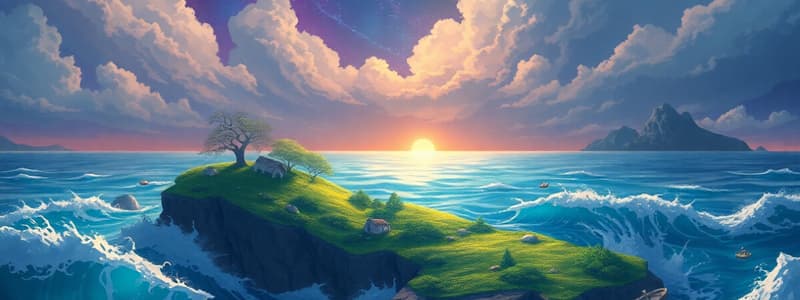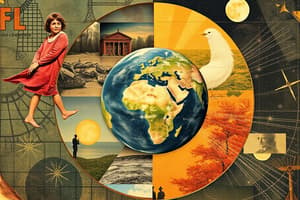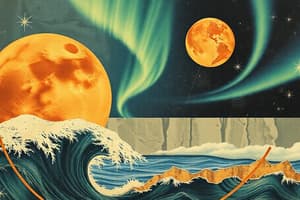Podcast
Questions and Answers
What primarily causes the seasons on Earth?
What primarily causes the seasons on Earth?
- The amount of sunlight received
- The rotation of the Earth
- The distance of Earth from the Sun
- The tilt of Earth's axis (correct)
During which event does the northern hemisphere experience the longest day of the year?
During which event does the northern hemisphere experience the longest day of the year?
- Winter solstice
- Vernal equinox
- Autumnal equinox
- Summer solstice (correct)
What happens in the northern hemisphere during the winter solstice?
What happens in the northern hemisphere during the winter solstice?
- It marks the beginning of summer.
- It is the longest night of the year. (correct)
- It is the shortest night of the year.
- Daylight hours are equal to nighttime hours.
When do the equinoxes occur?
When do the equinoxes occur?
What is the approximate tilt of Earth's axis?
What is the approximate tilt of Earth's axis?
How does the tilt of the hemispheres affect the seasons?
How does the tilt of the hemispheres affect the seasons?
What does the term 'equinox' signify?
What does the term 'equinox' signify?
What astronomical feature is associated with the extension of Earth's axis to space?
What astronomical feature is associated with the extension of Earth's axis to space?
What causes the two high tides experienced each day?
What causes the two high tides experienced each day?
During which lunar phases do spring tides occur?
During which lunar phases do spring tides occur?
What are neap tides and when do they occur?
What are neap tides and when do they occur?
Which of the following statements about the Bay of Fundy is true?
Which of the following statements about the Bay of Fundy is true?
How often do coastal areas experience high and low tides?
How often do coastal areas experience high and low tides?
Which factor significantly reduces the Sun's influence on tides compared to the Moon?
Which factor significantly reduces the Sun's influence on tides compared to the Moon?
What phenomenon describes the gradual shift in Earth's rotational axis?
What phenomenon describes the gradual shift in Earth's rotational axis?
What primary role do tides play in coastal ecosystems?
What primary role do tides play in coastal ecosystems?
What phenomenon results from the alignment of the Moon, Sun, and Earth?
What phenomenon results from the alignment of the Moon, Sun, and Earth?
Which of the following describes the process of precession?
Which of the following describes the process of precession?
Which statement is true regarding the cause of tides?
Which statement is true regarding the cause of tides?
What effect does the tilt of Earth's axis have on the seasons?
What effect does the tilt of Earth's axis have on the seasons?
During which astronomical event does the length of daylight decrease?
During which astronomical event does the length of daylight decrease?
Which of the following is NOT a phase of the Moon?
Which of the following is NOT a phase of the Moon?
How long does it take for the Earth to complete one revolution around the Sun?
How long does it take for the Earth to complete one revolution around the Sun?
What distinguishes a solar eclipse from a lunar eclipse?
What distinguishes a solar eclipse from a lunar eclipse?
Which planet type typically has a greater orbital radius?
Which planet type typically has a greater orbital radius?
Which of the following best describes the rotation of Earth?
Which of the following best describes the rotation of Earth?
What is the primary reason we see different phases of the Moon?
What is the primary reason we see different phases of the Moon?
How long does it take for Earth's axis to complete one full precession cycle?
How long does it take for Earth's axis to complete one full precession cycle?
Which phase of the Moon occurs immediately after the New Moon?
Which phase of the Moon occurs immediately after the New Moon?
What visual phenomenon occurs when Earth's rotational axis changes direction?
What visual phenomenon occurs when Earth's rotational axis changes direction?
Which Moon phase features the entire illuminated side facing Earth?
Which Moon phase features the entire illuminated side facing Earth?
What is a common misconception about the phases of the Moon?
What is a common misconception about the phases of the Moon?
What name is given to the point in the sky where the North Celestial Pole is located?
What name is given to the point in the sky where the North Celestial Pole is located?
During which phase is less than a full Moon visible but more than a half Moon?
During which phase is less than a full Moon visible but more than a half Moon?
What phase of the Moon is characterized by more than half of the illuminated surface being visible?
What phase of the Moon is characterized by more than half of the illuminated surface being visible?
What is a solar eclipse?
What is a solar eclipse?
During which lunar phase does the illuminated portion of the Moon begin to decrease?
During which lunar phase does the illuminated portion of the Moon begin to decrease?
What is the position of the Moon during a new moon phase?
What is the position of the Moon during a new moon phase?
How can the lunar cycle be best observed in a classroom setup?
How can the lunar cycle be best observed in a classroom setup?
What does the term 'eclipse' refer to?
What does the term 'eclipse' refer to?
What visible feature is displayed during a total solar eclipse?
What visible feature is displayed during a total solar eclipse?
Which of the following phases comes after the waxing gibbous phase?
Which of the following phases comes after the waxing gibbous phase?
What was a primary characteristic of the geocentric model proposed by Claudius Ptolemy?
What was a primary characteristic of the geocentric model proposed by Claudius Ptolemy?
How did Nicholas Copernicus's heliocentric model improve understanding of planetary motion?
How did Nicholas Copernicus's heliocentric model improve understanding of planetary motion?
What evidence did Galileo provide to support the heliocentric model?
What evidence did Galileo provide to support the heliocentric model?
What angle does Earth's rotational axis tilt from the vertical?
What angle does Earth's rotational axis tilt from the vertical?
When Earth is farthest from the Sun, why does the hemisphere tilted towards the Sun experience higher temperatures?
When Earth is farthest from the Sun, why does the hemisphere tilted towards the Sun experience higher temperatures?
During the time Earth is closest to the Sun, what happens to the hemisphere tilted away from the Sun?
During the time Earth is closest to the Sun, what happens to the hemisphere tilted away from the Sun?
What was one of the key observational tools used by Galileo to support the heliocentric model?
What was one of the key observational tools used by Galileo to support the heliocentric model?
What phenomenon occurs when the Moon aligns directly between the Earth and the Sun?
What phenomenon occurs when the Moon aligns directly between the Earth and the Sun?
What happens to the Moon's position relative to Earth over time?
What happens to the Moon's position relative to Earth over time?
During a total solar eclipse, which part of the Sun becomes visible?
During a total solar eclipse, which part of the Sun becomes visible?
Which type of eclipse can be observed from anywhere on Earth where the Moon is above the horizon?
Which type of eclipse can be observed from anywhere on Earth where the Moon is above the horizon?
What causes tidal movements in the oceans?
What causes tidal movements in the oceans?
When does a partial solar eclipse occur?
When does a partial solar eclipse occur?
What determines the color of the Moon during a total lunar eclipse?
What determines the color of the Moon during a total lunar eclipse?
How should a partial solar eclipse be viewed safely?
How should a partial solar eclipse be viewed safely?
Flashcards
Earth's Rotation
Earth's Rotation
The spinning of Earth on its axis, taking approximately 23 hours and 56 minutes to complete one rotation.
Earth's Precession
Earth's Precession
The gradual change in the direction of Earth's rotational axis, taking about 26,000 years to complete one cycle.
Gravity
Gravity
The force of attraction between any two objects with mass, causing planets to orbit the Sun.
Earth's Tilt and Seasons
Earth's Tilt and Seasons
Signup and view all the flashcards
Lunar Eclipse
Lunar Eclipse
Signup and view all the flashcards
Solar Eclipse
Solar Eclipse
Signup and view all the flashcards
Tides
Tides
Signup and view all the flashcards
Solstices
Solstices
Signup and view all the flashcards
Equinoxes
Equinoxes
Signup and view all the flashcards
Moon's Phases
Moon's Phases
Signup and view all the flashcards
Earth's Tilt
Earth's Tilt
Signup and view all the flashcards
Pole Star
Pole Star
Signup and view all the flashcards
Summer Solstice
Summer Solstice
Signup and view all the flashcards
Winter Solstice
Winter Solstice
Signup and view all the flashcards
Spring/Autumn
Spring/Autumn
Signup and view all the flashcards
Precession
Precession
Signup and view all the flashcards
Seasons
Seasons
Signup and view all the flashcards
What are tides?
What are tides?
Signup and view all the flashcards
How do tides form?
How do tides form?
Signup and view all the flashcards
How does the Sun affect tides?
How does the Sun affect tides?
Signup and view all the flashcards
What are spring tides?
What are spring tides?
Signup and view all the flashcards
What are neap tides?
What are neap tides?
Signup and view all the flashcards
Where are the highest tides on Earth?
Where are the highest tides on Earth?
Signup and view all the flashcards
How can we observe tides?
How can we observe tides?
Signup and view all the flashcards
How can tides be used as a renewable energy source?
How can tides be used as a renewable energy source?
Signup and view all the flashcards
Geocentric Model
Geocentric Model
Signup and view all the flashcards
Heliocentric Model
Heliocentric Model
Signup and view all the flashcards
Waxing Gibbous
Waxing Gibbous
Signup and view all the flashcards
Full Moon
Full Moon
Signup and view all the flashcards
Waning Gibbous
Waning Gibbous
Signup and view all the flashcards
Corona
Corona
Signup and view all the flashcards
Lunar Phases and Illumination
Lunar Phases and Illumination
Signup and view all the flashcards
Eclipse
Eclipse
Signup and view all the flashcards
What is Earth's precession?
What is Earth's precession?
Signup and view all the flashcards
Where is the North Celestial Pole?
Where is the North Celestial Pole?
Signup and view all the flashcards
What causes the Moon's phases?
What causes the Moon's phases?
Signup and view all the flashcards
What is a New Moon?
What is a New Moon?
Signup and view all the flashcards
What is a Waxing Crescent Moon?
What is a Waxing Crescent Moon?
Signup and view all the flashcards
What is a First Quarter Moon?
What is a First Quarter Moon?
Signup and view all the flashcards
What is a Waxing Gibbous Moon?
What is a Waxing Gibbous Moon?
Signup and view all the flashcards
What is a Full Moon?
What is a Full Moon?
Signup and view all the flashcards
What is a total solar eclipse?
What is a total solar eclipse?
Signup and view all the flashcards
What is a partial solar eclipse?
What is a partial solar eclipse?
Signup and view all the flashcards
What is a lunar eclipse?
What is a lunar eclipse?
Signup and view all the flashcards
Why is the Moon drifting away from Earth?
Why is the Moon drifting away from Earth?
Signup and view all the flashcards
What causes tides?
What causes tides?
Signup and view all the flashcards
Will total solar eclipses eventually stop?
Will total solar eclipses eventually stop?
Signup and view all the flashcards
What are total and partial lunar eclipses?
What are total and partial lunar eclipses?
Signup and view all the flashcards
Why does the Moon appear orange or red during a total lunar eclipse?
Why does the Moon appear orange or red during a total lunar eclipse?
Signup and view all the flashcards




